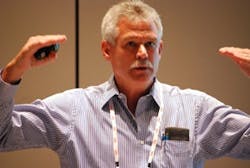Arkema Upgrades Polymer Production with 800xA and Profibus
If a few windows into your process application are good, then more will be better—especially if they're easier to set up and network.
For instance, Arkema Inc.'s refrigerant, polymer and hydrochloric acid plant in Calvert City, Ky., had been using Bailey Network90 controls in its Kynar polymer facility since 1988, and successfully expanded and upgraded them several times in the intervening years, including moving from panel board into a distributed control system (DCS). The facility now has eight process control units (PCUs) and 51 controllers, and its latest upgrade involved going to ABB's 800xA from its Harmony DCS in 2008.
The recently upgraded unit makes several grades of Kynar polymer and vinylidene fluoride (VF2) monomer. These high-grade polymers are used to give elasticity to paints and impart rust-proofing and sun-resistance capabilities to other types of coatings, according to Michael Smith, Arkema's senior staff plant instrument engineer.
Smith presented "Recent 800xA Applications at Arkema Calvert City" on the third day of ABB Automation and Power World 2010 at the George R. Brown Convention Center this week in Houston.
Smith added that Arkema's engineers also needed 800xA because they wanted their polymer application to be able to add more phases to existing process areas; establish a secure connection to the plant's wide-area network (WAN), including SAP and AutoManager P&IDs; improve asset optimization through better device management; and then implement new process areas, such as the AC800M controllers with connectivity to 800xA's Process Portal, as well as link to drives and motor control centers (MCCs).
Smith explained that Arkema's latest polymer application upgrade consisted of two main components—updating the de-ionized (DI) water system for making its polymers and a $16-million renovation of its sprayer dryer system for turning the product into powder before material-handling and shipping.
"Though we had a bottleneck on our Kynar process, we were a little overwhelmed to try to upgrade the whole sprayer dryer system at once. So when we were in a six-month construction mode period, we were able to do the pre-engineering and graphics for the DI system before taking on the larger project," explained Smith. "On the DI water system, we replaced old Allen-Bradley PLCs, gained experience with the AC800M controllers and S800 I/O; implemented the AC800M (PM861); utilized the PC Device library; tied into the existing 800xA system in the control rooms; and created the graphics. The DI water system also used to be on panel board, but we brought it all into the reactor control room and tied it into the existing system."
Likewise, to network its new 800xA system and controls, Smith and his colleagues decided to use Profibus and Ethernet. He added that the AC800M controllers and S800 IO slid easily into the existing panels in the field by the DI water units.
"The DI water application is fairly simply, but its regeneration phase can get a little complicated," said Smith. "However, once our engineers saw the graphics we were making and began to use them, we got a lot better buy-in from everyone.
"Engineers often feel pretty iffy about doing these kinds of graphics, but 800xA helps with a lot of pre-steps, such as color pallets, and then makes it easy to add symbols and devices later on. In fact, it only takes about half a day to make a pretty complex screen, but then you can just copy it over for other process units."
Similarly, to add a third spray dryer to its two existing spray dryers on the Harmony DCS, the planners needed to settle on controllers to replace the INFI 90 controllers used formerly; pick a software library method; opt for either fieldbus or S800 I/O; choose how to connect to downstream process interlocks; decide how to integrate other systems, such as drives and MCCs; pick an operator interface; and, hopefully, beat the project's internal budget estimate.
"Because our other two spray dryers were on the Harmony DCS, we needed the same look and feel for the third spray dryer using the AC800M controller and S800 remote I/O," explained Smith. "Also, we need to connect to the downstream process interlocks in our material-handling system and to avoid cramming powder into our downstream system. We also networked about 80 devices on Profibus via Pepperl+Fuchs segment couplers, and set up a Harmony PCU Gateway connection to the AC800M to interlock those downstream process signals."
Smith added that one of the main benefits of 800xA is that Arkema's staff can take its device type manager functions right out into the field, and communicate directly with any particular device. "You can check ABB's website for all the transmitters and other devices that are already integrated, or request that they add new ones, and then all this becomes pretty much plug-and-play," he said. "We wanted to use Profibus for networking because it can talk to our MCCs, so we didn't need so many other systems and networking protocols. We considered using Foundation fieldbus, but it's mostly for transmitters and control valves, so we would have had to add DeviceNet or another protocol for our variable-speed drives and motors. Profibus gives us one package, so we can see all our tabs and parameters on one screen, as well as all our interlocks too. We also have all our drive details, faults and values right from the drives. This is probably more information than we'll ever use, but it's there if we need it."
In addition, Arkema added its third spray dryer without needing any more operators, Smith said, and saved $500,000 on its $16-million budget for the project in the process.



